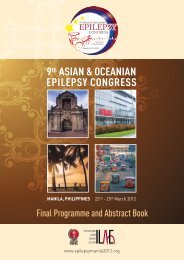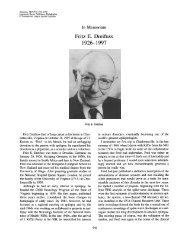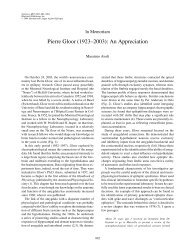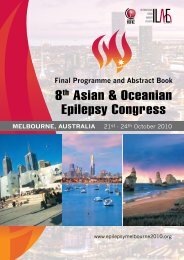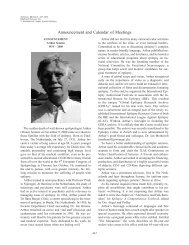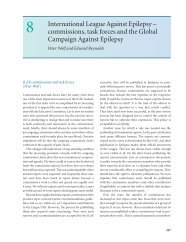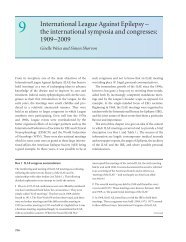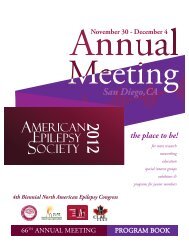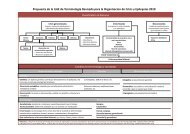SUNDAY December 7, 20088:00 a.m. – 4:15 p.m.Annual Course: Matching Treatments toSeizures and SyndromesCC – Ballroom 6COverviewInnovations in care for patients with epilepsy evolve rapidly. Thus, it isimpossible for the busy clinician to keep abreast of all the new treatments andtheir place in the therapy of epilepsy without getting a periodic comprehensiveupdate. This course is designed to provide clinicians who treat epilepsy with thenewest information about management of seizures and epilepsy syndromes.Discussion will focus on the numerous new therapies now available, includingmedications, diets, and surgical procedures and stimulators. The aim of thiscourse is to offer information so that the clinicians will be able to logicallychoose and offer the best therapy available for each epilepsy patient.Target AudienceNeurologists, epileptologists, nurse specialists, pharmacists and otherhealthcare professionalsLearner Outcomesu Increase the frequency with which you suspect a diagnosis of Dravetsyndrome in patients with refractory seizures coupled with certainphenotypic signsu Have increased knowledge of and confidence in your ability to prescribenewer therapies for seizure reduction in patients with Dravet syndromeu Identify and evaluate the pros and cons associated with treating and nottreating benign epilepsy of childhood with rolandic spikesu Avoid delay in offering advanced therapies to patients with atonic or tonicseizures that have proven refractory to frontline therapyu Select therapy for absence seizures that offers the best chance at seizurereduction and the least chance for seizure aggravation, based on the bestavailable evidenceu Select pharmacotherapy for JME in women of childbearing age that has thelowest risk for poor outcomes in future pregnancies, based on the bestavailable evidenceu Have increased confidence in your ability to select the best AED therapy forpatients with partial onset seizures.u Select pharmacotherapy for patients with refractory seizures that offer thebest chance at seizure reduction, based on the best available evidence.<strong>Program</strong>Co-Chairs: Elinor Ben-Menachem, M.D., Ph.D. and Michael Sperling, M.D.8:00 – 8:10 a.m. Introduction and Opening RemarksElinor Ben-Menachem, M.D., Ph.D.1. Dravet Syndrome8:10 – 8:40 a.m. Video Case PresentationEtiology and Diagnosis Even in the AdultPopulation: How to Find Patients andTreatment SuggestionsAlexis A. Arzimanoglu, M.D.Video Case Presentation – 20 years later2. Benign <strong>Epilepsy</strong> of Childhood with Rolandic Spikes8:40 – 9:10 a.m. Debate: To Treat or Not to Treat and If So,With What?W. Donald Shields, M.D. and O. Carter Snead III, M.D.3. Tonic and Atonic Seizures9:10 – 9:30 a.m. Video Case PresentationMedical Therapy and Ketogenic DietEileen P. G. Vining, M.D.Video Case Presentation – 20 years later9:30 – 10:00 a.m. Debate: What’s Next? VNS vs. Callosotomy?David W. Roberts, M.D. and William E. Rosenfeld, M.D.10:00 – 10:20 a.m. Break4. Absences10:20 – 10:40 a.m. Video Case PresentationTreatment Causes of Seizure Aggravation inIdiopathic Epilepsies, Especially AbsencesErnest Somerville, FRACPVideo Case Presentation – 20 years later10:40 – 11:10 a.m. Debate: Use a New AED or an Old One(VPA or ETH) as First Drug for Treatmentof Absence?L. James Willmore, M.D. and Patricia E. Penovich, M.D.5. Choice of AEDs in Women with Juvenile Myoclonic <strong>Epilepsy</strong>11:10 – 11:40 a.m. Video Case PresentationDebate: In a Girl, What Is the First LineTherapy? Use Valproate First vs. Use aNew AED First – Which One?Georgia D. Montouris, M.D. and Bassel W. Abou-Khalil, M.D.Video Case Presentation – 20 years later11:40 – 1:00 p.m. Lunch Break6. Partial Onset Seizures1:00 – 1:25 p.m. Tailoring Initial Drug Therapy to IndividualPatient Needs in Partial Onset SeizuresR. Eugene Ramsay, M.D.1:25 – 1:55 p.m. Debate: Should Enzyme Inducing Drugs BeConsidered as First Line Agents?Richard H. Mattson, M.D. and Scott Mintzer, M.D.7. Refractory Seizures1:55 – 2:15 p.m. Video Case PresentationTreatment Algorithms for Treating RefractoryPartial <strong>Epilepsy</strong>Barbara C. Jobst, M.D.Video Case Presentation – 20 years later2:15 – 2:45 p.m. Debate: Is There a Significant Advantage to BeGained by Trying Additional AEDs After Two HaveFailed or Go Directly to Early Surgery Evaluation?Patrick Kwan, M.D. and Michael Sperling, M.D.2:45 – 3:05 p.m. Break3:05 – 3:35 p.m. Debate: Rational Polytherapy: Is There Sucha Thing?Jacqueline A. French, M.D. and R. Edward Faught, Jr., M.D.(continued on page 41)40AES 62 ND ANNUAL MEETING 2nd Biennial North <strong>American</strong> Regional <strong>Epilepsy</strong> Congresswww.AESNET.org
SUNDAY December 7, 20083:35 – 4:05 p.m. Video Case PresentationSurgical Treatment of Extratemporal <strong>Epilepsy</strong>William E. Bingaman, M.D.Video Case Presentation – 20 years later4:05 – 4:15 p.m. ConclusionMichael Sperling, M.D.Credit DesignationThe <strong>American</strong> <strong>Epilepsy</strong> <strong>Society</strong> designates this educational activity for amaximum of 6.0 AMA PRA Category 1 Credits TM . Physicians should onlyclaim credit commensurate with the extent of their participation in theactivity.Pharmacy CreditACPE # 073-999-08-150-L01-P; 0.625 CEUsAcknowledgmentThis program is supported by educational grants from GlaxoSmithKline,Pfizer Inc., Valeant Pharmaceuticals International, Eisai and Ortho-McNeilNeurologics, Inc.8:00 a.m. – 5:45 p.m.Investigators’ WorkshopCC – Room numbers under each sessionOverviewThese workshops, conducted informally and designed to encourageinteraction, will address several important areas of rapidly emergingknowledge in clinical management and research in epilepsy. The workshopsare designed to identify challenges in current research, propose methods toovercome those challenges, and identify areas for future investigations.The four Clinical Investigators’ Workshops provide a series of workingseminars in areas of active clinical investigation and controversy. For eachworkshop, two or three investigators present current material during thefirst hour that is designed to generate and facilitate a constructivediscussion among speakers and audience participants for the remaining30 minutes. Workshops cover basic research germane to each topic inaddition to relevant and recent human studies. Speakers present resultsfrom their ongoing research and place their findings in the context ofcurrent understanding. This year’s topics include: Metabolic ChangesDuring Epileptic Discharges; Brain Stimulation for the Treatment of <strong>Epilepsy</strong>:What Is the Evidence in Humans and Animals?; The Relevance of InterictalDischarges in Childhood <strong>Epilepsy</strong>; and fMRI and Memory: Advances andPromises.The 11 Basic Science Workshops will highlight a number of research areaswhich have been developing rapidly over the last year. This year’s topicsinclude: Ion Channel Traffic Jams in <strong>Epilepsy</strong>; Reconsidering FocalIctogenesis; Catastrophic Childhood Epilepsies: Emerging Mechanisms fromExperimental Models; The Dentate “Gate”: What Is It, What Regulates It,and Is it Compromised in <strong>Epilepsy</strong>?; The Comorbidities of <strong>Epilepsy</strong>: TheUnification of Multiple Disease States Through Basic Mechanisms;Interactions within the Neurovascular Unit and Epileptogenesis; DoAnticonvulsants Injure the Immature Brain?; Absence Seizures and theCortical Focus; Idiopathic Generalized <strong>Epilepsy</strong> Itrogenesis andEpileptogenesis: A Cross-Disciplinary Discussion from Molecule to HumanBrain; New Developments in Neuroprotection; and Surrogate Markers inAnimal Models of Acquired <strong>Epilepsy</strong>: The Good, the Bad and the Ugly. Manyof these workshops have implications for future therapeutic strategies.The Basic Science Workshops are scheduled on three days of the Meeting.Most of the workshops will run as concurrent sessions on Sunday, whilethree non-concurrent workshops are scheduled for Saturday evening andMonday afternoon. This year we will feature one of the <strong>Epilepsy</strong> ResearchRecognition Award recipients in a keynote address on Sunday.Target AudienceBasic scientists, neurologists, neuroscientists, pharmacologists,neuropsychologists and neurosurgeons who are investigators performingstudies in epilepsy<strong>Program</strong>Investigators’ Workshop: Heinz Beck, M.D., ChairClinical Investigators’ Workshop: Vijay M. Thadani, M.D., Chair,Matthias J. Koepp, M.D., Ph.D., Vice ChairMorning Session I – 8:00 a.m. - 9:30 a.m.1. Metabolic Changes During Epileptic DischargesCC – Room 603Moderator: Jean Gotman, Ph.D.Speakers: Amir Schmuel, Ph.D., Hal Blumenfeld, M.D., Ph.D.,Theodore H. Schwartz, M.D., FACS, Jean Gotman, Ph.D.2. Reconsidering Focal IctogenesisCC – Room 607Moderator: Marco de Curtis, M.D.Speakers: Anatol Bragin, Ph.D., Marco de Curtis, M.D.Richard Miles, M.D., Peter L. Carlen, M.D.3. Catastrophic Childhood Epilepsies: Emerging Mechanisms fromExperimental ModelsCC – Room 612Moderator: Carl E. Stafstrom, M.D., Ph.D.Speakers: Eric Marsh, M.D., Ph.D., Libor Velisek, M.D., Ph.D.,Aristea Galanopoulou, M.D., Ph.D., Chong L. Lee, Ph.D.Break: 9:30 a.m. - 10:00 a.m.Morning Session II – 10:00 a.m. - 11:30 a.m.4. Brain Stimulation for the Treatment of <strong>Epilepsy</strong>: What Is theEvidence in Humans and Animals?CC – Room 612Moderator: Barbara C. Jobst, M.D.Speakers: Fred Lado, M.D., Ph.D.,Marcos Velasco, M.D., Ph.D., D. J. Mogul, Ph.D.5. Ion Channel Traffic Jams in <strong>Epilepsy</strong>CC – Room 607Moderator: Tallie Z. Baram, M.D., Ph.D.Speakers: Dax Hoffman, Dane M. Chetkovich, M.D., Ph.D.,Tallie Z. Baram, M.D., Ph.D., Christophe Bernard, Ph.D.6. New Developments In NeuroprotectionCC – Room 603Moderator: Karen S. Wilcox, Ph.D.Speakers: Karen S. Wilcox, Ph.D., Manisha N. Patel, Ph.D.,D. M. Chuang, H. Steve White, Ph.D.Poster Session for Basic Scientists – 11:30 a.m. - 1:30 p.m.Poster Session with Boxed LunchCC – Rooms 616-619Keynote Speakers – 1:30 p.m. - 2:00 p.m.Research Recognition Award Recipient (Basic Science)Frances Jensen, M.D.CC – Ballroom 6EResearch Recognition Award Recipient (Clinical)Anne T. Berg, Ph.D.CC – Room 612(continued on page 42)www.AESNET.orgAES 62 ND ANNUAL MEETING 2nd Biennial North <strong>American</strong> Regional <strong>Epilepsy</strong> Congress41
- Page 1 and 2: 2008AMERICAN EPILEPSY SOCIETY62 ND
- Page 3 and 4: WELCOME MESSAGEDear Friends:Welcome
- Page 5 and 6: TABLE OF CONTENTSMeetingInformation
- Page 7 and 8: SCHEDULE-AT-A-GLANCESUNDAY December
- Page 9 and 10: AES SPECIAL RECOGNITION2008 William
- Page 11 and 12: GENERAL INFORMATIONScientific Exhib
- Page 13 and 14: SECURITY & SAFETY INFORMATIONFirst
- Page 15 and 16: Look how AES continues toGO GREEN!R
- Page 17 and 18: FRIDAYDecember 5SCHEDULE8:00 a.m. -
- Page 19 and 20: FRIDAY December 5, 20081:30 p.m. -
- Page 21 and 22: FRIDAY December 5, 20088:30 p.m. -
- Page 23 and 24: SATURDAYDecember 6SCHEDULE7:00 a.m.
- Page 25 and 26: SATURDAY December 6, 2008ProgramCha
- Page 27 and 28: SATURDAY December 6, 2008Credit Des
- Page 29 and 30: Saturday December 6, 2008 Poster Se
- Page 31 and 32: Saturday December 6, 2008Poster Ses
- Page 33 and 34: Saturday December 6, 2008 Poster Se
- Page 35 and 36: Saturday December 6, 2008 Poster Se
- Page 37 and 38: Saturday December 6, 2008 Poster Se
- Page 39: SUNDAYDecember 7SCHEDULE7:00 a.m. -
- Page 43 and 44: SUNDAY December 7, 20086:00 p.m. -
- Page 45 and 46: Sunday December 7, 2008 Poster Sess
- Page 47 and 48: Sunday December 7, 2008 Poster Sess
- Page 49 and 50: Sunday December 7, 2008 Poster Sess
- Page 51 and 52: Sunday December 7, 2008Poster Sessi
- Page 53 and 54: Sunday December 7, 2008Poster Sessi
- Page 55 and 56: MONDAYDecember 8SCHEDULE7:00 a.m. -
- Page 57 and 58: MONDAY December 8, 20082.133 How Co
- Page 59 and 60: Monday December 8, 2008A. Translati
- Page 61 and 62: Monday December 8, 2008 Poster Sess
- Page 63 and 64: Monday December 8, 2008 Poster Sess
- Page 65 and 66: Monday December 8, 2008 Poster Sess
- Page 67 and 68: Monday December 8, 2008 Poster Sess
- Page 69 and 70: TUESDAYDecember 9SCHEDULE7:00 a.m.
- Page 71 and 72: TUESDAY December 9, 200812:45 p.m.
- Page 73 and 74: ABSTRACT AUTHOR INDEXAAarnoutse, E.
- Page 75 and 76: ABSTRACT AUTHOR INDEXCarrete, Jr.,
- Page 77 and 78: ABSTRACT AUTHOR INDEXFejerman, N.,
- Page 79 and 80: ABSTRACT AUTHOR INDEXHwang, D., IW.
- Page 81 and 82: ABSTRACT AUTHOR INDEXLitovchenko, T
- Page 83 and 84: ABSTRACT AUTHOR INDEXO’Connor, S.
- Page 85 and 86: ABSTRACT AUTHOR INDEXSantos, A.C.,
- Page 87 and 88: ABSTRACT AUTHOR INDEXTuranli, G., 2
- Page 89 and 90: COMMERCIAL SUPPORTER RECOGNITIONLea
- Page 91 and 92:
COMMERCIAL SUPPORTER RECOGNITIONSpo
- Page 93 and 94:
COMMERCIAL SUPPORTER RECOGNITIONCon
- Page 95 and 96:
SHERATON SEATTLE HOTELSheraton Seat
- Page 97 and 98:
CONVENTION CENTERLEVEL 4RREGISTRATI
- Page 99 and 100:
FPOPosition CD-Rom Here.-2 glue dot






